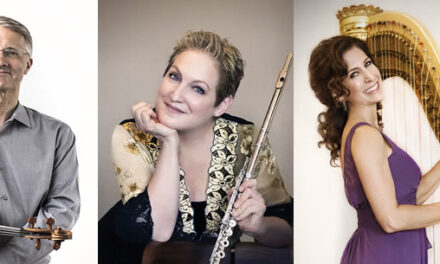Despite the plethora of classical music concerts in the Triangle, a scant few offer music composed before 1750. Of course, there’s plenty of Baroque wallpaper from our two classical music radio stations, but that’s largely background music with little regard by programmers for quality over quantity. Moreover, for some reason, the solo harpsichord gets short shrift overall.
It was, therefore, a rare treat to hear Rasia, a chamber ensemble featuring harpsichordist Elaine Funaro, violinist Allison Guest Edberg, flautist Akal Dev Sharonne and last minute substitute cellist, Durham’s Stephanie Vial (for the injured Eric Edberg) in “Something Old, Something New,” featuring Bach, Telemann and Haydn plus a world premiere by Bruce Lazarus. The group performed at Duke’s Griffith Film Theater on Saturday evening, July 7.
Rasia is a Hindi word denoting the emotion evoked by the arts, and we certainly experienced quite a dose of it. In J. S. Bach’s Trio Sonata in e minor, BWV 526, Haydn’s “London” Trio Sonata in G major and a Telemann Trio Sonata, the group followed the Baroque practice of substituting the instruments at hand for those specified in the original score. In all three works, the re-scoring was both effective and revealing. The Haydn Trio, originally scored for two flutes and cello, was perhaps the least successful; the passages in parallel thirds and sixths for the two upper instruments were often unbalanced simply because of the different timbres and volume of the flute and violin. Nevertheless, the violin, here providing the inner voice, gave a new perspective on this popular work because of its sheer volume.
The Bach Trio Sonata, originally conceived for organ, whose flexibility allows for innumerable variations in sonority, has been transcribed frequently for other instruments. In this case, the difference in sonority between the flute and violin worked better because of the more contrapuntal nature of the work. The Telemann, scored for the same combination of instruments, is a lovely and musically interesting piece, superior in quality to many works in similar vein produced by this most prolific of composers. Because so much of Telemann’s work is used as musical wallpaper, it is gratifying to hear a fine specimen performed in the concert hall where the listener can really focus on it.
Because of Eric Edberg’s indisposition, Rasia was forced to alter its original program, which had included the Tapestry Concerto by contemporary composer Albert Glinsky. With a last minute substitute, they wisely concentrated on the world premiere of Bruce Lazarus’s Alpha Centauri , which provided more than enough challenge for Vial, who did an outstanding job on all fronts. A cross between minimalism and boogie-woogie in the first movement, Alpha Centauri is a rhythmically complex work in which an ostinato and short motives are passed around like a Frisbee among the harpsichord, violin, flute and cello. Similarly to the program itself, Alpha Centauri incorporates the old and the new. The jazzy rhythms and harmonies are set within a conservative three-movement architecture (fast-slow-fast). The brief and lyrical middle movement serves a similar function to the transitional slow movements in many Baroque sonatas and concerti.
For the Glinsky, Rasia substituted a Spanish Suite for solo harpsichord by Timothy Brown. Although the work won first prize at the Aliénor Harpsichord Composition Competition of 2000, it was pretty bland and derivative. But then, it is enormously difficult to write Spanish music that is truly fresh. Unfortunately for our appreciation of the Brown work, it was followed by Jacque Ibert’s Two Interludes for Harpsichord, Violin and Flute, written as incidental music to a 1930s reworking of The Trickster of Seville by 17th century playwright Tirso de Molina. The second Interlude is a particularly creative take on the old Flamenco clichés.
We hope to hear more from Rasia in the future. As well as providing the best Baroque programs in the area, Funaro is one of the leading promoters of contemporary harpsichord music. Her new CD, “Overture to Orpheus, Music written for women who gave wing to the muse” has just been released. Look for a review coming soon to CVNC.org.











